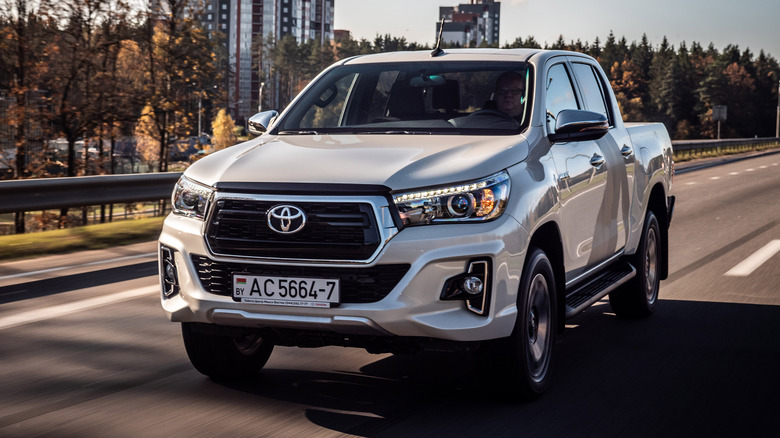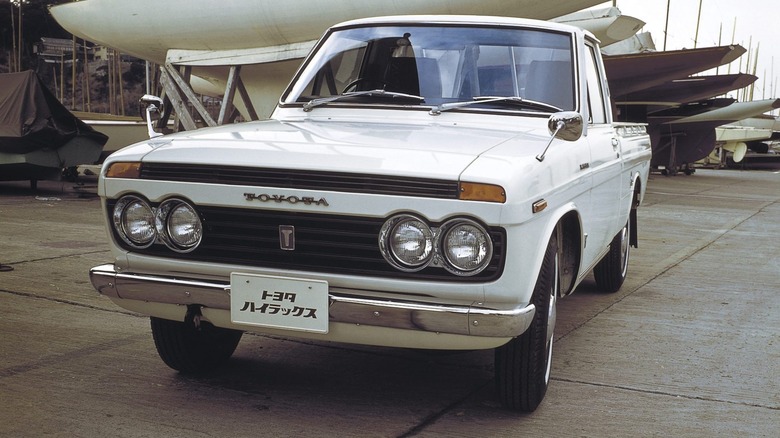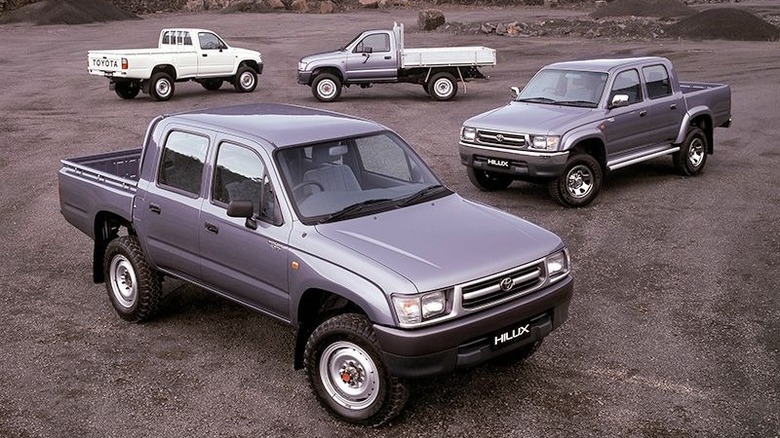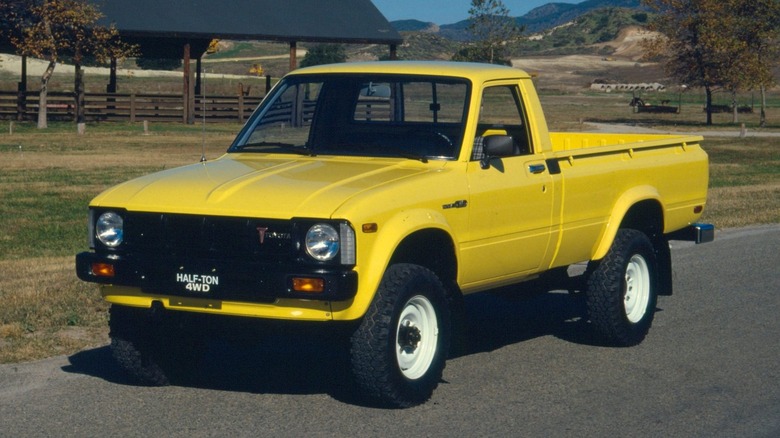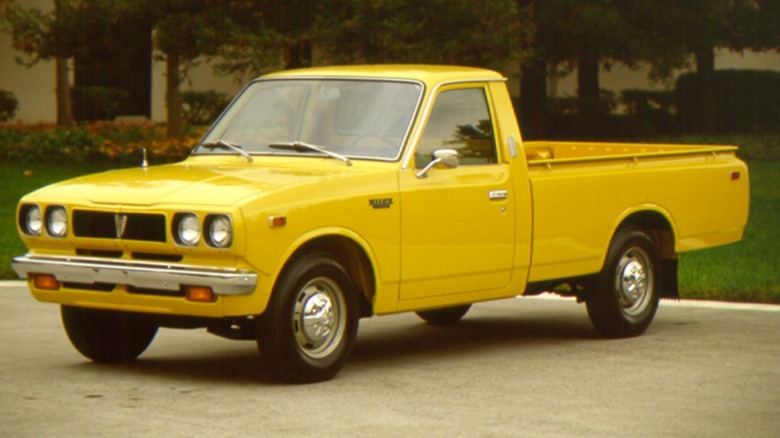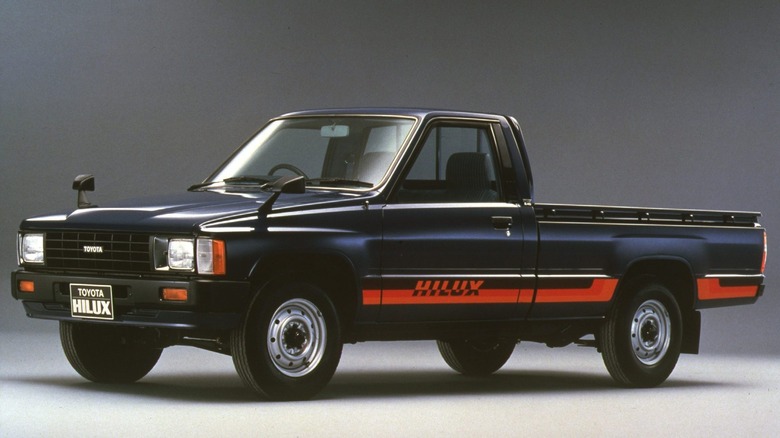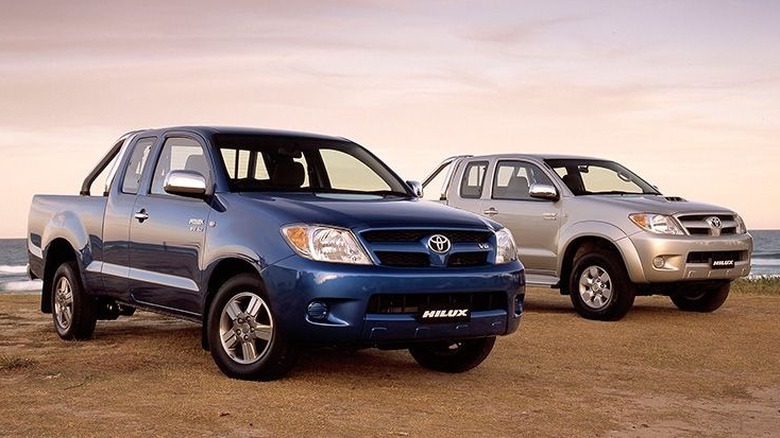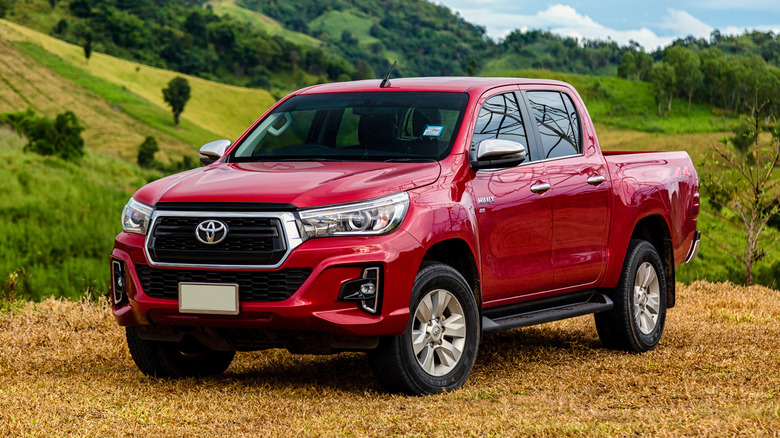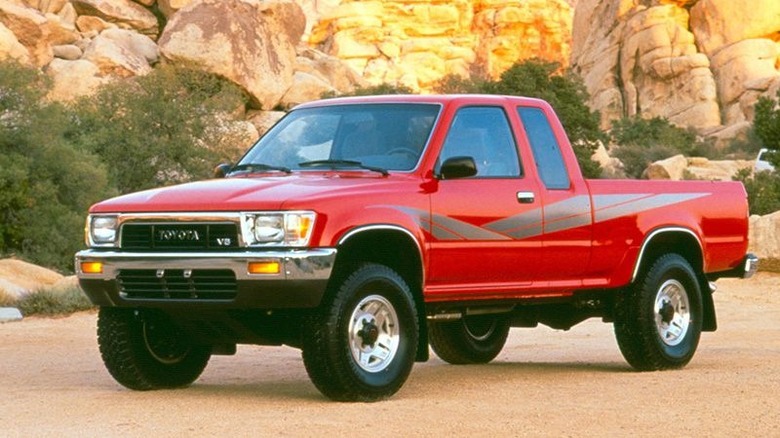Every Toyota Hilux Generation Ranked Worst To Best
Since its introduction in 1968, the Toyota Hilux has garnered a global reputation as one of the most dependable pickup trucks ever produced. This distinguished status has been forged over a span of more than 55 years, during which millions of Hilux trucks have been sold worldwide.
The name Hilux itself is derived from the combination of high and luxury, a title it has truly earned in contemporary times. Originating as a modest work truck, the Hilux has since evolved into a powerful luxury vehicle renowned for its exceptional comfort, consistent reliability, and impressive strength. It has gained the trust of companies and families alike in challenging terrain, ensuring safety and security. In remarkable instances, the Hilux has even served as a reliable combat vehicle.
The Toyota Hilux has changed in a lot of big ways over its history, which now spans eight distinct generations. While some iterations featured more substantial improvements than others, every generation contributed unique advancements. We're taking a look at every Toyota Hilux generation and then ranking them from worst to best, looking at overall improvements over preceding generations, drivability, reliability, and the profound impact each Hilux had on the automotive industry.
8. 1st Generation (1968-1972)
The first-generation Hilux marks the beginning of an iconic legacy. Created as a replacement for the Toyota Stout, the initial version of the Hilux was designated as the RN10 model.
Equipped with Toyota's R series 1.5-liter straight-4 engine that produced 76 hp, the Hilux RN10 boasted a hauling capacity of approximately 1,000 kg. Its design featured a 2-door, rear-wheel drive configuration with a compact cab. If you compare it to today's modern trucks, you're likely to be sorely disappointed, but this venerable vehicle saw service in the late 60s and early 70s. Not only were these specs rather impressive at the time, but they were also the foundation of reliability that would be one of the defining features of the Hilux.
The birth of the Hilux legend and its unwavering dependability can be traced back to this inaugural generation. While it remains an extraordinary vehicle cherished by collectors, subsequent generations have consistently improved upon its foundation. Considering the era it thrived in, the RN10 Hilux excelled in terms of specifications, capabilities, and reliability, making it one of the most trustworthy trucks of its time.
Over the course of its lifespan, the RN10 received an upgraded 1.6-liter engine and underwent minor improvements that would eventually allow it to make up to 109 hp. Even today, a functional RN10 is highly sought after by classic car enthusiasts and devoted Hilux fans. However, it is worth noting that the first generation ranks lower simply because Toyota has continuously refined and enhanced the original design, leaving the RN10 unable to compete with its successors.
7. 6th Generation (1997-2004)
The sixth generation of the Hilux, encompassing models N140, N150, N160, and N170, represented a significant step in the Hilux lineage. The September 1997 launch of the sixth generation Hilux brought forth two distinct lines: a truck line tailored for commercial purposes and a sports pickup line designed for personal use. In November, an additional model, the extra cab, was introduced. This open-deck multi-purpose vehicle could be configured with a long cargo bed or two seats in the rear cabin area.
While not particularly groundbreaking, the sixth generation was good for consumers as Toyota began advancing its designs toward a more modern aesthetic. In terms of mechanical components, the transition from the fifth to the sixth generation brought about minimal changes. The engine and internal workings remained largely unchanged. Instead, the focus shifted towards enhancing the size and comfort of the vehicle. Toyota recognized the potential for the Hilux to cater to the multi-purpose vehicle market.
These improvements resulted in a noteworthy upgrade, rendering the Hilux significantly more comfortable for everyday driving. Driveability and comfort were enhanced without compromising its inherent utility as a pickup truck. Nevertheless, when compared to the advancements seen in other generations of the Hilux, the changes implemented in the sixth generation were relatively minor and, although they provided increased comfort, weren't particularly exciting.
6. 3rd Generation (1978-1983)
Drivers in the USA would be forgiven for not remembering the Hilux name or even thinking that America may have banned the Hilux due to their relative rarity. However, the truth is that by the third generation, the Hilux was rebranded as the Toyota Pickup for marketing purposes within the United States.
Designated as the N30 and N40 models, the third-generation Hilux was the first iteration to offer 4-wheel drive options. However, this feature was exclusively available on models equipped with Toyota 2-liter engines (such as the 18R) or larger. Smaller engines remained an option but were limited to rear-wheel drive configurations.
This generation is often likened to a reliable tool, comparable to a sturdy wrench or a traditional set of drill bits. When treated properly, they have remarkable durability and longevity. The third-generation Hilux is renowned for its outstanding reliability. Those lucky enough to find one that hasn't been left to the elements will find that the third-generation Hilux is a workhorse vehicle that still performs. At this point in time, however, many third-gen Hiluxes will have rust damage or need replacement parts. Still, they remain widely available and relatively cheap.
Comfort is not a strong suit of the third-gen Hilux. While the cab size surpasses that of its predecessor, it remains pretty bare bones in nature. This design approach aligns with its intended purpose as a functional work truck and not much more.
5. 2nd Generation (1972-1978)
The second generation is where you start to see the Hilux develop the reliability, comfort, and drive that it's known for today. This generation was known as the N20 model. The difference between the first generation and the second generation is night and day.
Since the initial design of the Hilux drew heavily from the Briska and Stout truck lines, it wasn't until the second generation that the defining characteristics of the compact truck truly emerged. Produced from 1972 to 1978, the N20 featured an overall larger frame compared to its predecessor, the RN10. The introduction of several new engine options further enhanced its versatility, although the most common was the 2-liter 18R engine, although this was also the first model to also include the smaller 1.6-liter engine with an automatic transmission.
It was during this second generation that the Hilux name was first dropped in favor of the Toyota Truck or Pickup. No matter its name, the N20 swiftly gained a reputation as a reliable small truck that proved ideal for daily use, particularly among industrial workers. One of the major improvements in this generation was the interior cab. Toyota prioritized overall comfort by enlarging the cab and equipping it with more comfortable seats. This shift in design philosophy transformed the Hilux from a purely commercial vehicle into a hybrid truck that catered to both personal and commercial needs.
4. 4th Generation (1983-1988)
The fourth generation of Hilux comprises models N50, N60, and N70, all of which played a significant role in converting non-Hilux enthusiasts into ardent fans. This generation, particularly the N50, solidified its legendary status as one of the most durable commercially available trucks in the world thanks in part to three individuals: James May, Richard Hammond, and Jeremy Clarkson.
The esteemed hosts of "Top Gear" decided to subject the reputation of the N50 Hilux to an extreme test. They found an N50 model Hilux with an impressive mileage of approximately 190,000 miles on the odometer and launched a relentless mission to push the Hilux to its limits. The N50 Hilux was set on fire, subjected to multiple crashes, driven off ledges, and even left atop a building earmarked for demolition. Despite all the punishment inflicted upon it, the Hilux engine managed to start and continue running. Undoubtedly battered and bruised, the Hilux remained resilient and survived the ordeal.
Few other trucks have been subjected to such an extraordinary spectacle, and even fewer would have been able to withstand such destruction. This remarkable display of durability is why the fourth-generation Hilux, to this day, remains one of the most sought-after and globally acclaimed vehicles renowned for its reliability.
Of course, there's one other name mentioned in reference to the fourth generation Hilux — Marty McFly, the fictional character played by Micheal J. Fox, who receives a fourth generation Hilux at the end of "Back to the Future."
3. 7th Generation (2004-2015)
The seventh generation of Hilux, comprising the AN10, AN20, and AN30 models, represented a notable leap in size compared to its predecessor. This increase in size allowed Toyota to revamp the interiors, prioritizing comfort for drivers and passengers. This generation was part of Toyota's Innovative International Multi-Purpose Vehicle project (IMV), which aimed to optimize global production processes by utilizing a common platform to create different products. The seventh-generation Hilux is one of the models resulting from this endeavor.
While the seventh generation embraced modern amenities and conveniences by catering to the needs of everyday drivers, it still provided options for heavy towing and raw power. One engine option included a rugged 4-liter V6 engine, while another option catered to users seeking the strength of up to a 3-liter diesel engine.
The remarkable capabilities of the Hilux caught the attention of the television show "Top Gear" once again, prompting them to subject a modified seventh-generation Hilux to another demanding test. This time, they successfully drove the vehicle to the North Pole. In a subsequent episode, the same Hilux underwent further modifications and achieved the extraordinary feat of driving up an active volcano, reaching its summit. From extreme cold to intense heat, the Hilux consistently exceeded expectations under the most extreme conditions.
In 2012, a modified version of the seventh-generation Hilux also participated in the grueling Dakar Rally. Giniel de Villiers demonstrated exceptional performance throughout the rally, consistently placing in the top three with this generation of the Hilux.
2. 8th Generation (2015-Present)
The eighth generation of Hilux, comprising the AN110, AN120, and AN130 models, represents the latest iteration of this iconic vehicle. Toyota has skillfully blended new technologies with the Hilux's well-established reputation for reliability, delivering a generation that embodies its vision of "redefining toughness."
Toyota went beyond mere specifications and engine power in pursuit of this goal, taking a holistic approach to the design of the Hilux while considering the needs of the driver. Toyota focused heavily on redesigning the cab for safety and comfort. The eighth-generation Hilux models boast larger dimensions and offer objectively greater luxury and comfort. This redesign was prompted by a keen understanding of drivers who rely on the Hilux as a work vehicle, often spending long hours behind the wheel.
In addition, visibility within the cab was enhanced, taking into account the demands of city driving. This impressive generation places a strong focus on enhancing the overall user experience, and the results speak for themselves. The eighth-generation Hilux received the prestigious 6th International Pick-Up Award for 2022/2023, serving as a testament to its technological advancements, exceptional comfort, and enduring reputation of reliability over five decades in the making.
The eighth and most recent generation Hilux stands as the culmination of Toyota's commitment to excellence, blending cutting-edge technology with the utmost consideration for driver satisfaction and the demands of a wide range of driving scenarios.
1. 5th Generation (1988-1997)
The fifth generation Hilux includes the N80, N90, N100, and N110 models. To this day, the fifth generation is still one of the best versions out there. This wasn't the most comfortable, strongest, or fastest Hilux on the market — but it's the embodiment of what a truck should be.
The fifth-gen Hilux is an indestructible beast on the road, displaying remarkable durability. It set itself apart from competitors by employing a complete box frame, a design choice that rendered it substantially stronger than other offerings in the market. Combined with Toyota's renowned reputation, this feature contributed to its immense popularity, particularly as a reliable work truck.
For outdoor enthusiasts seeking adventure in off-roading and trailblazing capabilities, the Hilux became an easy choice. The fifth-generation Hilux could take a beating no matter what task drivers wanted it for, and it usually came out the other side unscathed. Furthermore, when repairs were necessary, the fifth-generation Hilux was known for its ease of maintenance and repairability.
While newer Hilux models have emerged, offering increased speed, strength, and comfort, the fifth generation remains a true embodiment of what a truck should be. It exuded reliability, provided an enjoyable driving experience, and proved its longevity over time. Despite the presence of more advanced alternatives, the fifth-generation Hilux retains its timeless appeal as a rugged and enduring companion.
